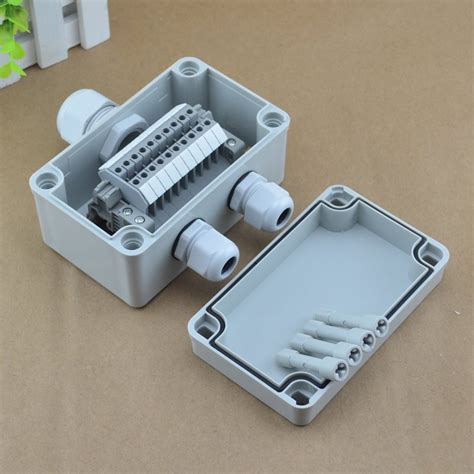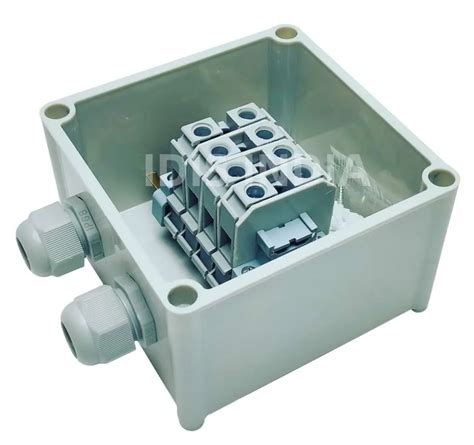difference between terminal box and junction box Discover the key differences between terminal and junction boxes, their functionalities, materials, and a head-to-head comparison. Learn to tell them apart easily. As homeowners, it’s important to be aware of all the different types of house keys available to protect your home. While most are familiar with the standard mechanically cut keys, other options for house keys include double or four .
0 · small junction box with terminals
1 · large junction box with terminals
2 · large junction box with knockouts
3 · junction boxes with terminal blocks
4 · junction box with terminal strip
5 · electrical junction boxes plastic bunnings
6 · electrical junction box with terminals
7 · 1 inch deep junction box
Unlock the potential of CNC machinery with our detailed overview of the 11 main types of CNC machine operations and processes. Perfect for enthusiasts and professionals looking to deepen their understanding of CNC technology.
Discover the key differences between terminal and junction boxes, their functionalities, materials, and a head-to-head comparison. Learn to tell them apart easily.
Muitas vezes as pessoas confundem terminais e caixas de junção devido às .In this article, we’ll look at the major differences between a Terminal and a . Features of Terminal Box compared to Junction Box. There are some distinct features that distinguish a junction box from a terminal box. Let’s take a look at the two: .Both junction boxes and terminal boxes play vital roles in electrical installations, protecting and housing electrical connections. Understanding their unique characteristics and suitable applications is crucial for making the right choice .
Junction box = box with no components mounted in it (i.e. all connections are wirenuts or split bolts). Most conductors are long enough to be pulled from the box (i.e. the 6" .
small junction box with terminals
large junction box with terminals
Terminal boxes are generally used when the wiring or connections are intended to remain as they are without modifications. Junction Box: Junction boxes have a larger working . What’s the difference between outlet boxes and junction boxes? An outlet box and a junction box can be the same thing. A junction box is a standard electrical box that encloses wire splices and contains no device (like .In this article, we’ll look at the major differences between a Terminal and a junction box. Continue reading! A junction box, sometimes called a j-box, is a protective box that connects all of the power supply cables. These boxes are .When selecting terminal or junction boxes, correct size and adequate protection are the priorities. When considering quality of protection, material type and professional rating systems are the .
A junction box – also known as an ‘electrical box’, ‘jbox’, ‘or ‘terminal box’ – is a protective box where wires are interconnected. Junction boxes are often built into the plaster of a wall, in the ceiling, or within concrete.Discover the key differences between terminal and junction boxes, their functionalities, materials, and a head-to-head comparison. Learn to tell them apart easily. Knowing the difference between nction boxes and terminal blocks helps you pick the right tool for electrical projects. Both organize and protect connections, but each has unique purposes, benefits, and limitations. Key Differences Between Junction Boxes and Terminal Blocks

Features of Terminal Box compared to Junction Box. There are some distinct features that distinguish a junction box from a terminal box. Let’s take a look at the two: Junction Box Features. i. An enclosure made of either metal or polymer. ii. Set of wire connectors. iii. Has entry and exit points on the enclosure surface. iv.Both junction boxes and terminal boxes play vital roles in electrical installations, protecting and housing electrical connections. Understanding their unique characteristics and suitable applications is crucial for making the right choice for your specific wiring needs.
large junction box with knockouts
Junction box = box with no components mounted in it (i.e. all connections are wirenuts or split bolts). Most conductors are long enough to be pulled from the box (i.e. the 6" length required at devices) Terminal boxes are generally used when the wiring or connections are intended to remain as they are without modifications. Junction Box: Junction boxes have a larger working area and are designed to accommodate multiple connections and wiring.
What’s the difference between outlet boxes and junction boxes? An outlet box and a junction box can be the same thing. A junction box is a standard electrical box that encloses wire splices and contains no device (like a receptacle).In this article, we’ll look at the major differences between a Terminal and a junction box. Continue reading! A junction box, sometimes called a j-box, is a protective box that connects all of the power supply cables. These boxes are also affixed to the roof, the wall, and the concrete plaster.When selecting terminal or junction boxes, correct size and adequate protection are the priorities. When considering quality of protection, material type and professional rating systems are the deciding factors. A junction box – also known as an ‘electrical box’, ‘jbox’, ‘or ‘terminal box’ – is a protective box where wires are interconnected. Junction boxes are often built into the plaster of a wall, in the ceiling, or within concrete.
sheet metal supply
Discover the key differences between terminal and junction boxes, their functionalities, materials, and a head-to-head comparison. Learn to tell them apart easily. Knowing the difference between nction boxes and terminal blocks helps you pick the right tool for electrical projects. Both organize and protect connections, but each has unique purposes, benefits, and limitations. Key Differences Between Junction Boxes and Terminal Blocks Features of Terminal Box compared to Junction Box. There are some distinct features that distinguish a junction box from a terminal box. Let’s take a look at the two: Junction Box Features. i. An enclosure made of either metal or polymer. ii. Set of wire connectors. iii. Has entry and exit points on the enclosure surface. iv.Both junction boxes and terminal boxes play vital roles in electrical installations, protecting and housing electrical connections. Understanding their unique characteristics and suitable applications is crucial for making the right choice for your specific wiring needs.
Junction box = box with no components mounted in it (i.e. all connections are wirenuts or split bolts). Most conductors are long enough to be pulled from the box (i.e. the 6" length required at devices) Terminal boxes are generally used when the wiring or connections are intended to remain as they are without modifications. Junction Box: Junction boxes have a larger working area and are designed to accommodate multiple connections and wiring. What’s the difference between outlet boxes and junction boxes? An outlet box and a junction box can be the same thing. A junction box is a standard electrical box that encloses wire splices and contains no device (like a receptacle).
In this article, we’ll look at the major differences between a Terminal and a junction box. Continue reading! A junction box, sometimes called a j-box, is a protective box that connects all of the power supply cables. These boxes are also affixed to the roof, the wall, and the concrete plaster.When selecting terminal or junction boxes, correct size and adequate protection are the priorities. When considering quality of protection, material type and professional rating systems are the deciding factors.

junction boxes with terminal blocks
Discover the essential types of ductwork for HVAC efficiency in our guide. Explore the advantages of flexible, rigid, and semi-rigid ducts, and learn how material choices like galvanized steel or fiberglass affect your system's performance and air quality.
difference between terminal box and junction box|electrical junction boxes plastic bunnings